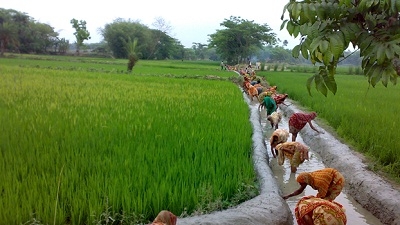Challenge
The seasonal job drought hits the poorest the hardest as they struggle to put food on the table and cater for basic needs of their families. Men are forced to leave for the city in search of employment, leaving women and children in the villages. Reaching these people, the ‘most vulnerable’ in society, has always been the greatest challenge for the Government of Bangladesh. The lack of effective targeting of government resources, transparency and accountability within the food distribution system as well as reliable monitoring to ensure results are being achieved, are key challenges that prevent resources from reaching these vulnerable populations.
The sheer scale of poverty in Bangladesh and the limited fiscal space in government budgets given the on-going global financial crisis mean that both recipient governments and donors alike are looking for smart programs that allow for a maximum social return on investment. By focusing on providing short term employment on community subprojects to enable households to better cope with vulnerability while strengthening government implementation capacity, the EGPP is an example of such a smart program.
Solution
The EGPP targets the most vulnerable in society in a number of ways. First, a greater proportion of funds are channeled to the poorest Upazilas (sub-districts), especially along the coastal regions. Second, only households with less than half an acre of land and where the household head is a manual laborer are eligible. Third, wages are set at below market wage level to attract only those who need the money the most. Furthermore, one-third of all beneficiaries include women. This gender quota increases the probability of particularly female-headed households who are particularly vulnerable, to benefit from EGPP. Male and female beneficiaries receive the same amount of daily wages, making the program particularly attractive for poor women.
The EGPP is a new generation of safety net programs that places extra emphasis on innovations and results while improving transparency and monitoring. Independent spot checks reveal consistent improvement in program implementation, namely in the area of systematic formalization of institutional arrangements based on continuous feedback from the field.
The World Bank through the International Development Association (IDA) has been supporting EGPP through a results-based credit whereby funds are released upon achievement of results in the areas of improved targeting, better monitoring and evaluation and increased use of better governance measures. This approach creates incentives for efficiency and allows for innovation, making the EGPP the dynamic program it is today.
With additional grant funding, the IDA is also supporting pilot projects aimed at testing electronic worker attendance systems that linked to payments using mobile phones and Postal Cash Cards Since 2010, the EGPP has provided over 164 million employment days and distributed a total of $363 million in wage income. With only five years in operation, the EGPP has become one of the largest safety net programs in Bangladesh and received the highest increase in Government budget allocation in FY 2012-13 and again in FY 2013-14.


